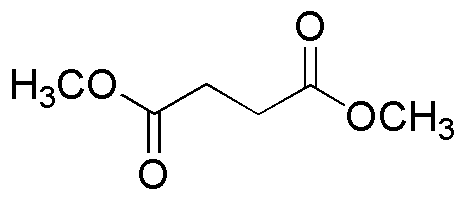Dimethyl succinate is widely utilized in research focused on:
- Solvent Applications: It serves as an effective solvent in various chemical reactions and formulations, particularly in the production of coatings, adhesives, and inks, enhancing the performance of these products.
- Flavor and Fragrance Industry: This compound is used as a flavoring agent and fragrance component, providing a fruity aroma in food products and perfumes, making it popular in the culinary and cosmetic sectors.
- Polymer Production: Dimethyl succinate is a key building block in the synthesis of biodegradable polymers, which are increasingly important in reducing plastic waste and promoting sustainability in packaging and materials.
- Pharmaceuticals: It plays a role in the synthesis of various pharmaceutical compounds, contributing to the development of effective medications and therapies, particularly in the field of drug delivery systems.
- Biofuel Development: The compound is explored as a potential intermediate in the production of biofuels, offering a renewable alternative to fossil fuels and aligning with global sustainability goals.
General Information
Properties
Safety and Regulations
Applications
Dimethyl succinate is widely utilized in research focused on:
- Solvent Applications: It serves as an effective solvent in various chemical reactions and formulations, particularly in the production of coatings, adhesives, and inks, enhancing the performance of these products.
- Flavor and Fragrance Industry: This compound is used as a flavoring agent and fragrance component, providing a fruity aroma in food products and perfumes, making it popular in the culinary and cosmetic sectors.
- Polymer Production: Dimethyl succinate is a key building block in the synthesis of biodegradable polymers, which are increasingly important in reducing plastic waste and promoting sustainability in packaging and materials.
- Pharmaceuticals: It plays a role in the synthesis of various pharmaceutical compounds, contributing to the development of effective medications and therapies, particularly in the field of drug delivery systems.
- Biofuel Development: The compound is explored as a potential intermediate in the production of biofuels, offering a renewable alternative to fossil fuels and aligning with global sustainability goals.
Documents
Safety Data Sheets (SDS)
The SDS provides comprehensive safety information on handling, storage, and disposal of the product.
Product Specification (PS)
The PS provides a comprehensive breakdown of the product’s properties, including chemical composition, physical state, purity, and storage requirements. It also details acceptable quality ranges and the product's intended applications.
Certificates of Analysis (COA)
Search for Certificates of Analysis (COA) by entering the products Lot Number. Lot and Batch Numbers can be found on a product’s label following the words ‘Lot’ or ‘Batch’.
*Catalog Number
*Lot Number
Certificates Of Origin (COO)
This COO confirms the country where the product was manufactured, and also details the materials and components used in it and whether it is derived from natural, synthetic, or other specific sources. This certificate may be required for customs, trade, and regulatory compliance.
*Catalog Number
*Lot Number
Safety Data Sheets (SDS)
The SDS provides comprehensive safety information on handling, storage, and disposal of the product.
DownloadProduct Specification (PS)
The PS provides a comprehensive breakdown of the product’s properties, including chemical composition, physical state, purity, and storage requirements. It also details acceptable quality ranges and the product's intended applications.
DownloadCertificates of Analysis (COA)
Search for Certificates of Analysis (COA) by entering the products Lot Number. Lot and Batch Numbers can be found on a product’s label following the words ‘Lot’ or ‘Batch’.
*Catalog Number
*Lot Number
Certificates Of Origin (COO)
This COO confirms the country where the product was manufactured, and also details the materials and components used in it and whether it is derived from natural, synthetic, or other specific sources. This certificate may be required for customs, trade, and regulatory compliance.

